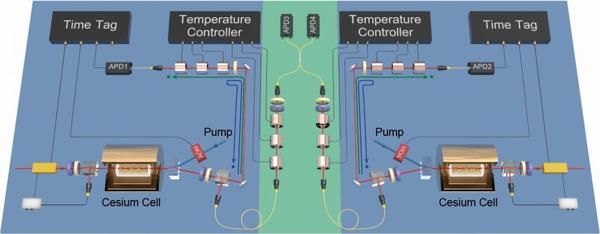Establishing quantum entanglement between remote nodes is the fundamental primitive for quantum information processing. Due to the increasing photon loss and noise in the channel, quantum repeater scheme is the most promising way to establish the long-distance entanglement, where entanglements are preliminarily generated between intermediate nodes and then extended via linking the adjacent segments by entanglement swapping.
Quantum repeater scheme necessitates the nodes functioning as quantum memories in this hierarchical architecture, synchronizing the probabilistic generation of the entanglement for each segment. Besides, the realization of entanglement swapping is usually based on the quantum interference between photons from neighboring nodes, which requires the indistinguishability of photons from different repeater nodes.
The indistinguishability of photons can be demonstrated by the Hong–Ou–Mandel (HOM) interference. So far, HOM interference between photons from two single-photon sources has mainly been realized in cryogenic temperature and well-isolated systems, such as cold atomic ensembles, nitrogen vacancy centers, trapped ions, and so on. On the other hand, recent development has shown interest in room-temperature systems, which offer better scalability as they are free from the complex cooling apparatus.
Relative progress has been reported in room-temperature systems, for example, quantum interference between two single p hotons from the spontaneous four-wave mixing (SFWM) process in room-temperature atomic ensembles and the HOM interference between photons retrieved from two room-temperature EIT memories. However, the ability of realizing repeater nodes with memory capability in room-temperature systems and simultaneously obtaining indistinguishable photons retrieved from them remains to be proved.
To address this problem, the research group led by Prof. Xianmin Jin at Shanghai Jiao Tong University presents an experimental demonstration of HOM interference between single photons from two independent room-temperature quantum memories. The observed visibility of quantum interference is up to 75.0% without reduction of any background noise, well exceeding the classical limit of 50%. Relevant research results were published in Photonics Research, Volume 10, No. 10, 2022 (Chao-Ni Zhang, Hang Li, Jian-Peng Dou, Feng Lu, Hong-Zhe Yang, Xiao-Ling Pang, Xian-Min Jin. Hong–Ou–Mandel interference linking independent room-temperature quantum memories[J]. Photonics Research, 2022, 10(10): 2388).
The researchers manage to prepare two heralded and low-noise single-photon sources based on room-temperature quantum memories by a far-off-resonance Duan–Lukin–Cirac–Zoller protocol. The visibility of HOM interference is not only affected by photon indistinguishability, but also related to the multi-photon component of the photon sources (As shown in the figure).

Fig. Experimental Setup of Hong–Ou–Mandel interference linking independent room-temperature quantum memories.
By choosing appropriate energy of control pulses, a good trade-off between the rate of four-fold coincidence and the interference visibility is achieved. Besides, the researchers also successfully enhance the Hong–Ou–Mandel interference rate up to about 15 times by increasing each photon rate, which is achieved by coordinating two quantum memories with a repeat-until-success fashion.
After carefully engineering photons to be identical in all degrees of freedom, the observed visibility of the HOM interference between single photons from two independent room-temperature quantum memories is about 75%, exceeding the classical limit of 50%.
Along with the develop of lifetime and low noise level in recent progress, our result certifies the feasibility for engineering, manipulating, and transferring quantum resources with room-temperature quantum memories, and the realization of large-scale quantum networks at ambient condition.


